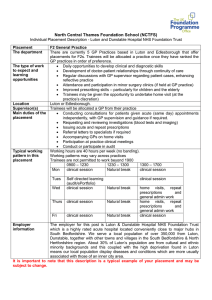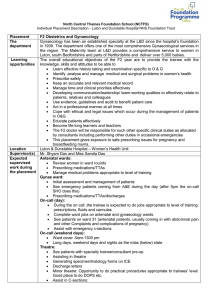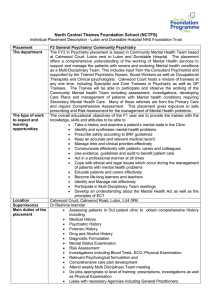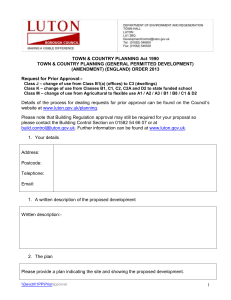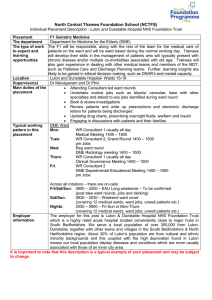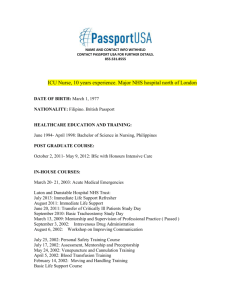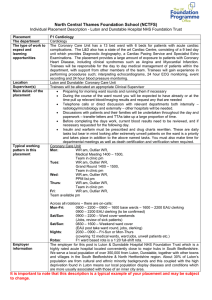North Central Thames Foundation School (NCTFS)
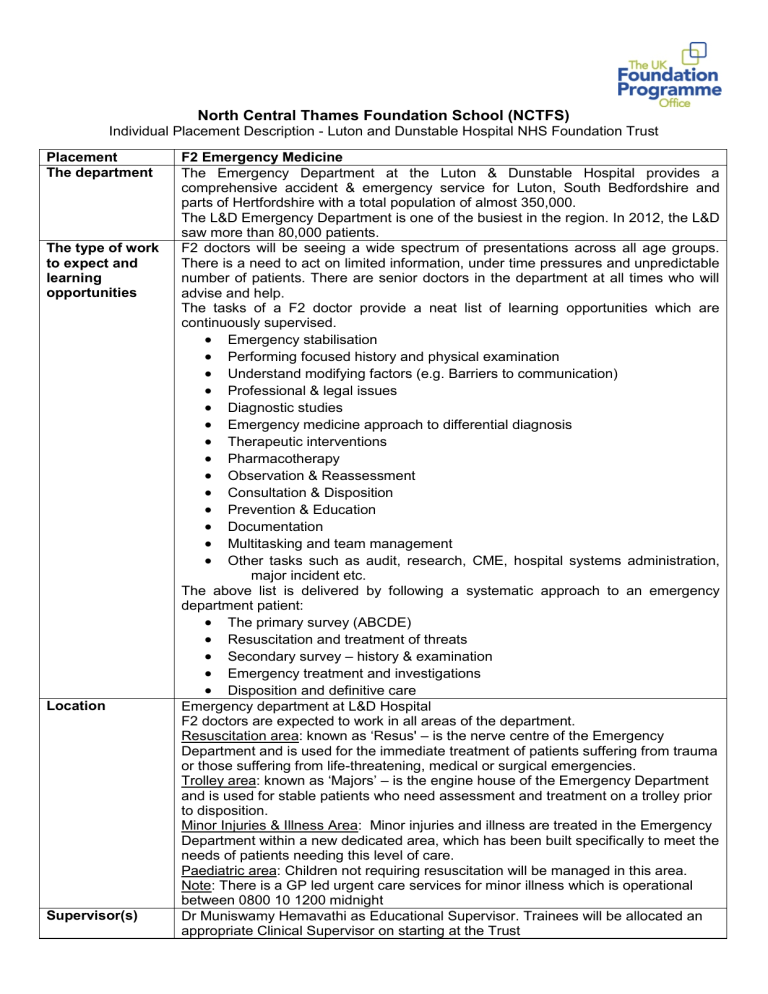
North Central Thames Foundation School (NCTFS)
Individual Placement Description - Luton and Dunstable Hospital NHS Foundation Trust
Placement F2 Emergency Medicine
The department The Emergency Department at the Luton & Dunstable Hospital provides a
The type of work to expect and learning opportunities
Location comprehensive accident & emergency service for Luton, South Bedfordshire and parts of Hertfordshire with a total population of almost 350,000.
The L&D Emergency Department is one of the busiest in the region. In 2012, the L&D saw more than 80,000 patients.
F2 doctors will be seeing a wide spectrum of presentations across all age groups.
There is a need to act on limited information, under time pressures and unpredictable number of patients. There are senior doctors in the department at all times who will advise and help.
The tasks of a F2 doctor provide a neat list of learning opportunities which are continuously supervised.
Emergency stabilisation
Performing focused history and physical examination
Understand modifying factors (e.g. Barriers to communication)
Professional & legal issues
Diagnostic studies
Emergency medicine approach to differential diagnosis
Therapeutic interventions
Pharmacotherapy
Observation & Reassessment
Consultation & Disposition
Prevention & Education
Documentation
Multitasking and team management
Other tasks such as audit, research, CME, hospital systems administration, major incident etc.
The above list is delivered by following a systematic approach to an emergency department patient:
The primary survey (ABCDE)
Resuscitation and treatment of threats
Secondary survey – history & examination
Emergency treatment and investigations
Disposition and definitive care
Emergency department at L&D Hospital
F2 doctors are expected to work in all areas of the department.
Resuscitation area : known as ‘Resus' – is the nerve centre of the Emergency
Supervisor(s)
Department and is used for the immediate treatment of patients suffering from trauma or those suffering from life-threatening, medical or surgical emergencies.
Trolley area : known as ‘Majors’ – is the engine house of the Emergency Department and is used for stable patients who need assessment and treatment on a trolley prior to disposition.
Minor Injuries & Illness Area: Minor injuries and illness are treated in the Emergency
Department within a new dedicated area, which has been built specifically to meet the needs of patients needing this level of care.
Paediatric area: Children not requiring resuscitation will be managed in this area.
Note: There is a GP led urgent care services for minor illness which is operational between 0800 10 1200 midnight
Dr Muniswamy Hemavathi as Educational Supervisor. Trainees will be allocated an appropriate Clinical Supervisor on starting at the Trust
Main duties of the placement
“…initial evaluation, treatment, and disposition of any person at any time for any symptom, event or disorder deemed by the person – or someone acting on his or her behalf – to require expeditious medical, surgical or psychiatric attention” (Clinical
Practice of emergency medicine as described by Hamilton). To deliver on this philosophy whilst acknowledging the tremendous challenges and opportunities it creates.
F2 doctors work the junior doctors Rota. This is a 7 day on & 2 day off Rota. 7 days Typical working pattern in this placement
Employer information are worked consecutively with 2 rest days after each 7 days and 9 rest days after 7 nights.
The following shifts apply: 0700 – 1600, 1500 – 2400 and the night shift 2300 – 0800.
Protected didactic teaching happens weekly for 2 hours. This is consultant led teaching and is of very high quality and directly relevant to Emergency Medicine
The employer for this post is Luton & Dunstable Hospital NHS Foundation Trust which is a highly rated acute hospital located conveniently close to major hubs in
South Bedfordshire. We serve a local population of over 350,000 from Luton,
Dunstable, together with other towns and villages in the South Bedfordshire & North
Hertfordshire region. About 30% of Luton’s population are from cultural and ethnic minority backgrounds and this coupled with the high deprivation found in Luton means our local population display diseases and conditions which are more usually associated with those of an inner city area.
It is important to note that this description is a typical example of your placement and may be subject to change.
